Analyzing COVID-19 Impact on Workplace Transformation at ALDI
VerifiedAdded on 2023/06/14
|12
|2595
|57
Report
AI Summary
This report investigates the impact of the COVID-19 pandemic on workplace transformation within ALDI, a German-based supermarket chain with a global presence. The study aims to understand the concept of workplace transformation, identify its need and importance in light of the pandemic, and explore the challenges faced by ALDI in adapting its workplace practices. The research employs a qualitative approach, utilizing interpretivism philosophy and thematic analysis of data collected from both primary (employee surveys) and secondary sources (literature review). The findings reveal both positive and negative impacts on ALDI's operations, including compliance with safety protocols, the rise of remote work, decreased accuracy in some tasks, and challenges in coordination. The report concludes with recommendations for improving workplace transformation practices, such as organizing training sessions and establishing centralized communication networks, to ensure smoother operations and achievement of organizational goals during and after the pandemic. Desklib provides access to this report and other study resources for students.
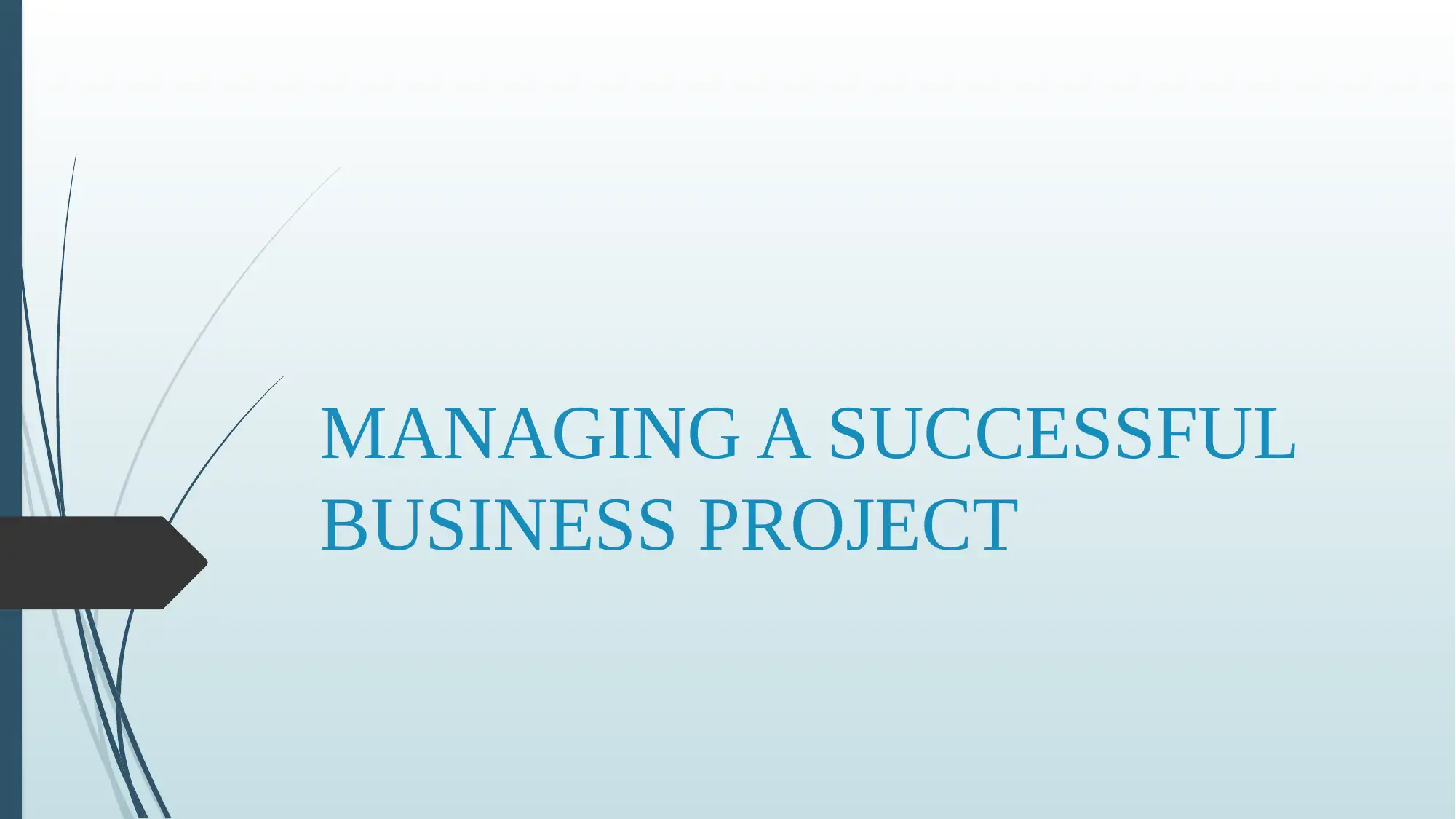
MANAGING A SUCCESSFUL
BUSINESS PROJECT
BUSINESS PROJECT
Paraphrase This Document
Need a fresh take? Get an instant paraphrase of this document with our AI Paraphraser
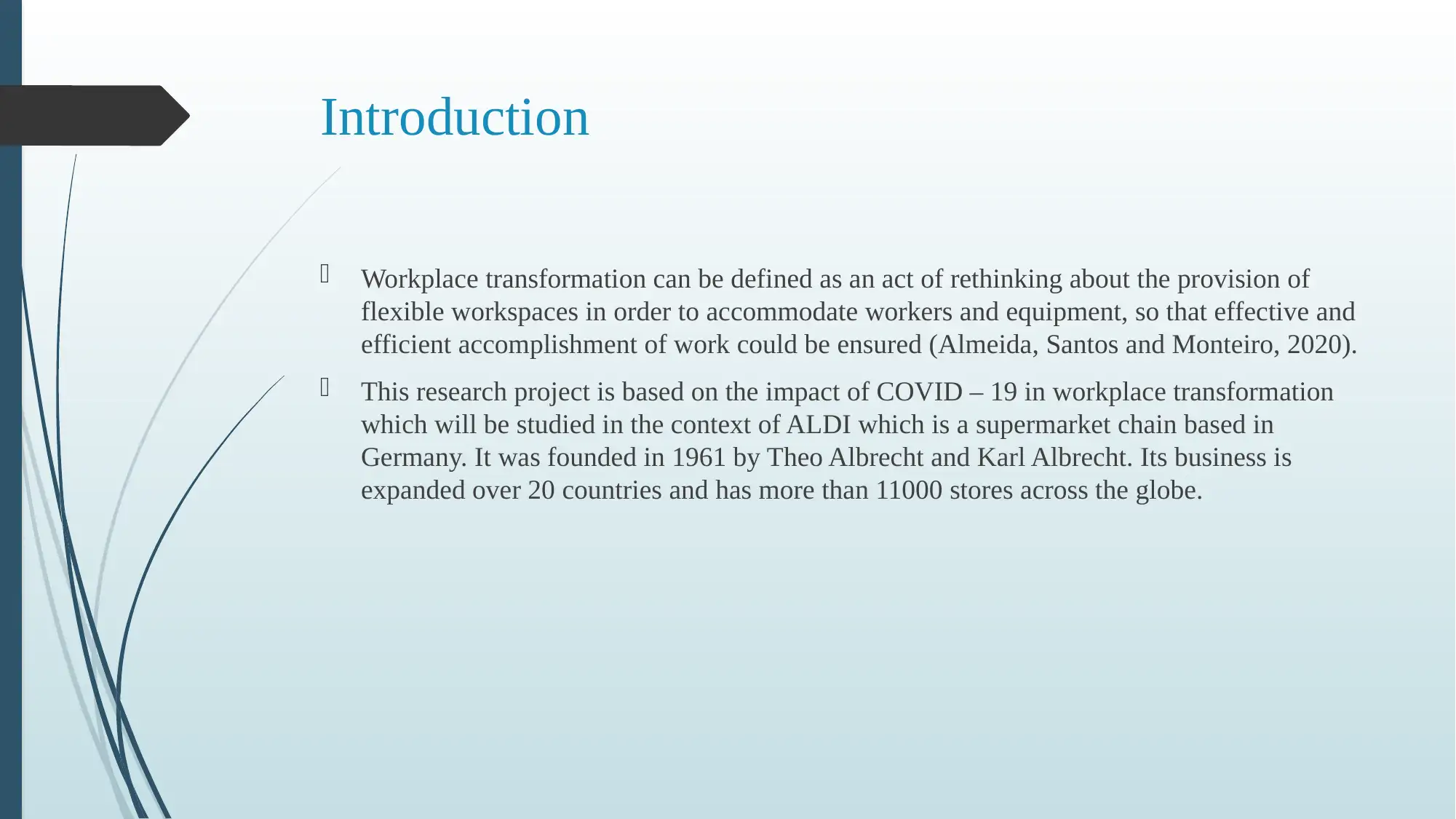
Introduction
Workplace transformation can be defined as an act of rethinking about the provision of
flexible workspaces in order to accommodate workers and equipment, so that effective and
efficient accomplishment of work could be ensured (Almeida, Santos and Monteiro, 2020).
This research project is based on the impact of COVID – 19 in workplace transformation
which will be studied in the context of ALDI which is a supermarket chain based in
Germany. It was founded in 1961 by Theo Albrecht and Karl Albrecht. Its business is
expanded over 20 countries and has more than 11000 stores across the globe.
Workplace transformation can be defined as an act of rethinking about the provision of
flexible workspaces in order to accommodate workers and equipment, so that effective and
efficient accomplishment of work could be ensured (Almeida, Santos and Monteiro, 2020).
This research project is based on the impact of COVID – 19 in workplace transformation
which will be studied in the context of ALDI which is a supermarket chain based in
Germany. It was founded in 1961 by Theo Albrecht and Karl Albrecht. Its business is
expanded over 20 countries and has more than 11000 stores across the globe.
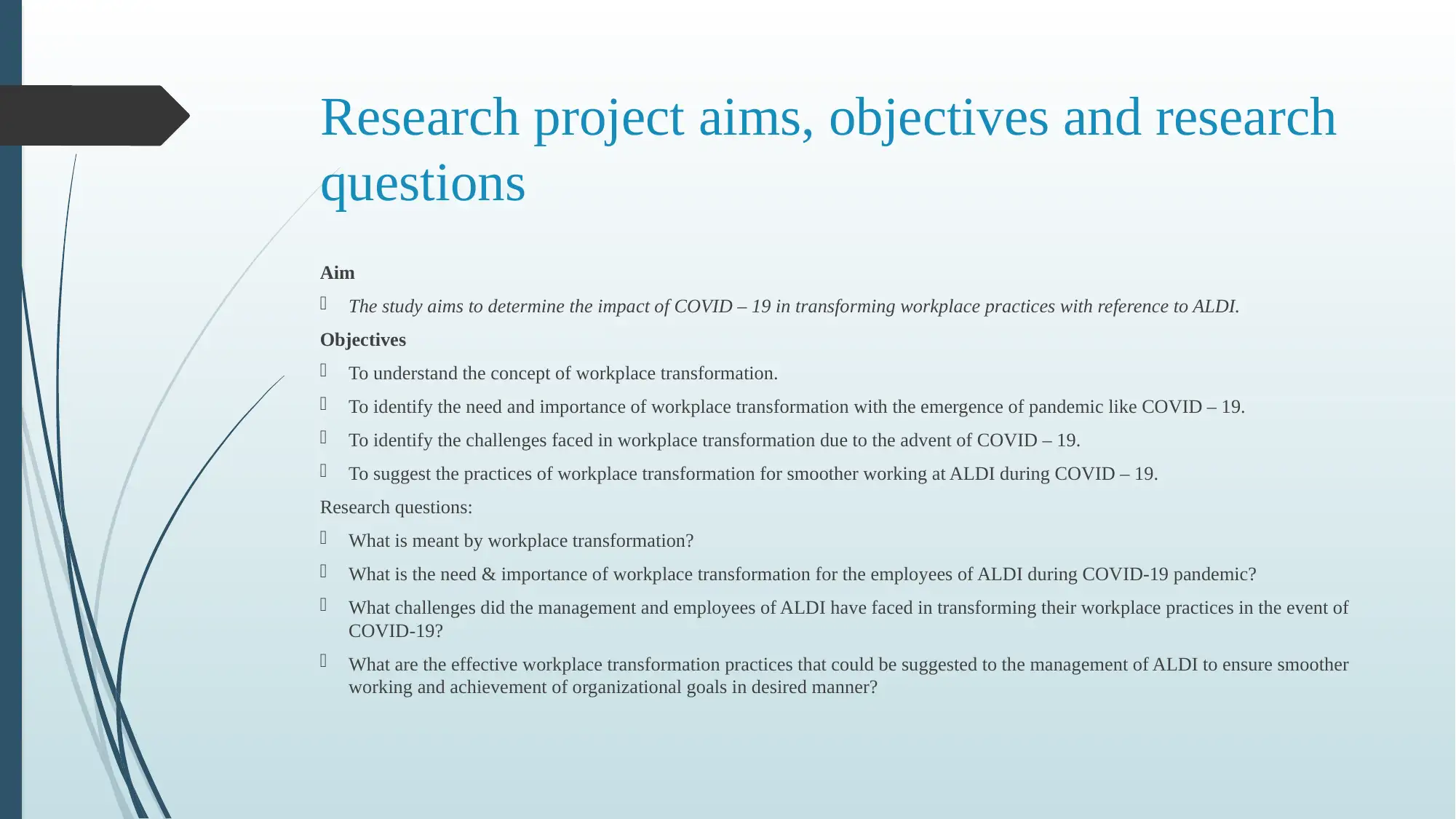
Research project aims, objectives and research
questions
Aim
The study aims to determine the impact of COVID – 19 in transforming workplace practices with reference to ALDI.
Objectives
To understand the concept of workplace transformation.
To identify the need and importance of workplace transformation with the emergence of pandemic like COVID – 19.
To identify the challenges faced in workplace transformation due to the advent of COVID – 19.
To suggest the practices of workplace transformation for smoother working at ALDI during COVID – 19.
Research questions:
What is meant by workplace transformation?
What is the need & importance of workplace transformation for the employees of ALDI during COVID-19 pandemic?
What challenges did the management and employees of ALDI have faced in transforming their workplace practices in the event of
COVID-19?
What are the effective workplace transformation practices that could be suggested to the management of ALDI to ensure smoother
working and achievement of organizational goals in desired manner?
questions
Aim
The study aims to determine the impact of COVID – 19 in transforming workplace practices with reference to ALDI.
Objectives
To understand the concept of workplace transformation.
To identify the need and importance of workplace transformation with the emergence of pandemic like COVID – 19.
To identify the challenges faced in workplace transformation due to the advent of COVID – 19.
To suggest the practices of workplace transformation for smoother working at ALDI during COVID – 19.
Research questions:
What is meant by workplace transformation?
What is the need & importance of workplace transformation for the employees of ALDI during COVID-19 pandemic?
What challenges did the management and employees of ALDI have faced in transforming their workplace practices in the event of
COVID-19?
What are the effective workplace transformation practices that could be suggested to the management of ALDI to ensure smoother
working and achievement of organizational goals in desired manner?
⊘ This is a preview!⊘
Do you want full access?
Subscribe today to unlock all pages.

Trusted by 1+ million students worldwide
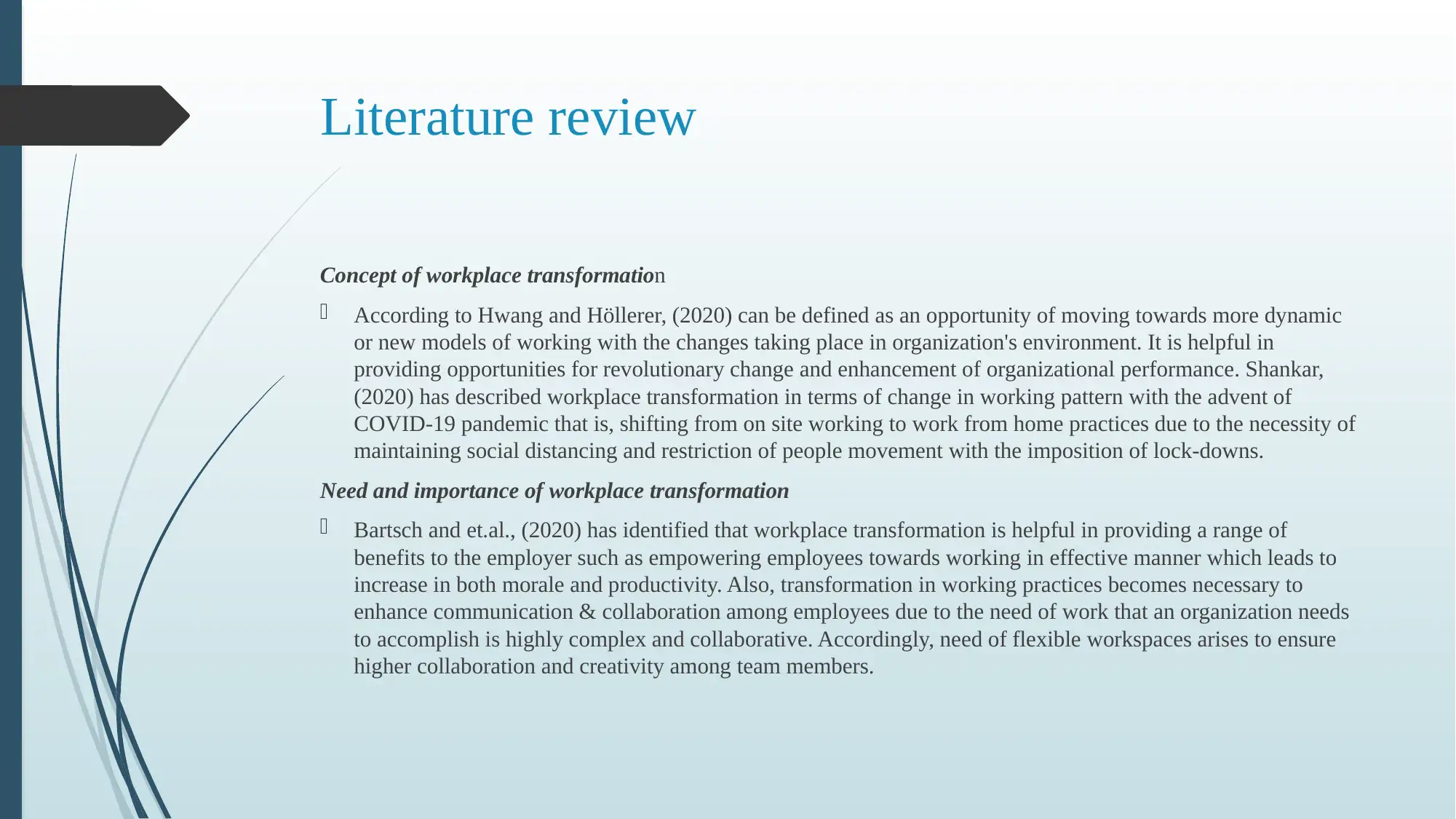
Literature review
Concept of workplace transformation
According to Hwang and Höllerer, (2020) can be defined as an opportunity of moving towards more dynamic
or new models of working with the changes taking place in organization's environment. It is helpful in
providing opportunities for revolutionary change and enhancement of organizational performance. Shankar,
(2020) has described workplace transformation in terms of change in working pattern with the advent of
COVID-19 pandemic that is, shifting from on site working to work from home practices due to the necessity of
maintaining social distancing and restriction of people movement with the imposition of lock-downs.
Need and importance of workplace transformation
Bartsch and et.al., (2020) has identified that workplace transformation is helpful in providing a range of
benefits to the employer such as empowering employees towards working in effective manner which leads to
increase in both morale and productivity. Also, transformation in working practices becomes necessary to
enhance communication & collaboration among employees due to the need of work that an organization needs
to accomplish is highly complex and collaborative. Accordingly, need of flexible workspaces arises to ensure
higher collaboration and creativity among team members.
Concept of workplace transformation
According to Hwang and Höllerer, (2020) can be defined as an opportunity of moving towards more dynamic
or new models of working with the changes taking place in organization's environment. It is helpful in
providing opportunities for revolutionary change and enhancement of organizational performance. Shankar,
(2020) has described workplace transformation in terms of change in working pattern with the advent of
COVID-19 pandemic that is, shifting from on site working to work from home practices due to the necessity of
maintaining social distancing and restriction of people movement with the imposition of lock-downs.
Need and importance of workplace transformation
Bartsch and et.al., (2020) has identified that workplace transformation is helpful in providing a range of
benefits to the employer such as empowering employees towards working in effective manner which leads to
increase in both morale and productivity. Also, transformation in working practices becomes necessary to
enhance communication & collaboration among employees due to the need of work that an organization needs
to accomplish is highly complex and collaborative. Accordingly, need of flexible workspaces arises to ensure
higher collaboration and creativity among team members.
Paraphrase This Document
Need a fresh take? Get an instant paraphrase of this document with our AI Paraphraser
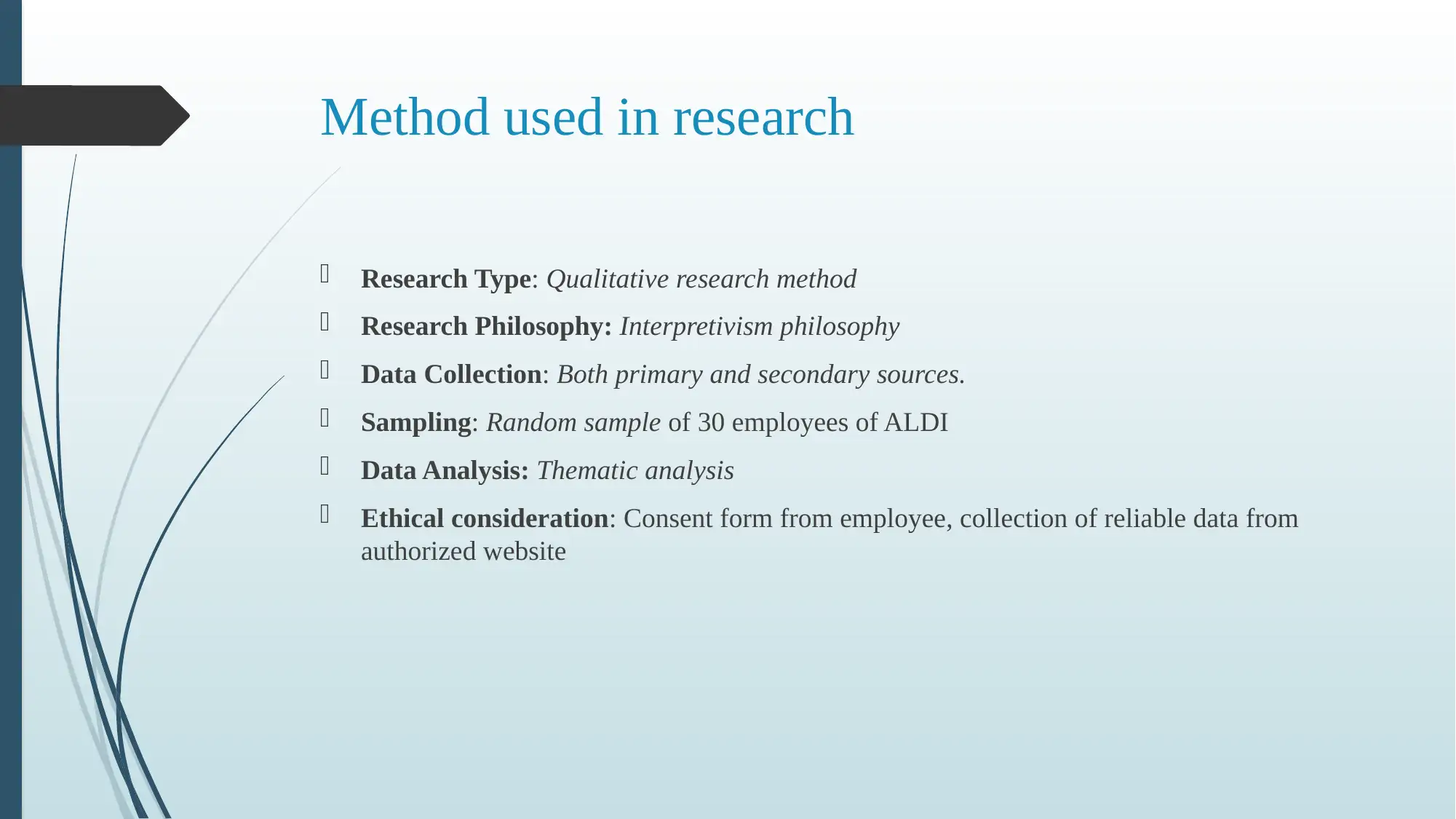
Method used in research
Research Type: Qualitative research method
Research Philosophy: Interpretivism philosophy
Data Collection: Both primary and secondary sources.
Sampling: Random sample of 30 employees of ALDI
Data Analysis: Thematic analysis
Ethical consideration: Consent form from employee, collection of reliable data from
authorized website
Research Type: Qualitative research method
Research Philosophy: Interpretivism philosophy
Data Collection: Both primary and secondary sources.
Sampling: Random sample of 30 employees of ALDI
Data Analysis: Thematic analysis
Ethical consideration: Consent form from employee, collection of reliable data from
authorized website
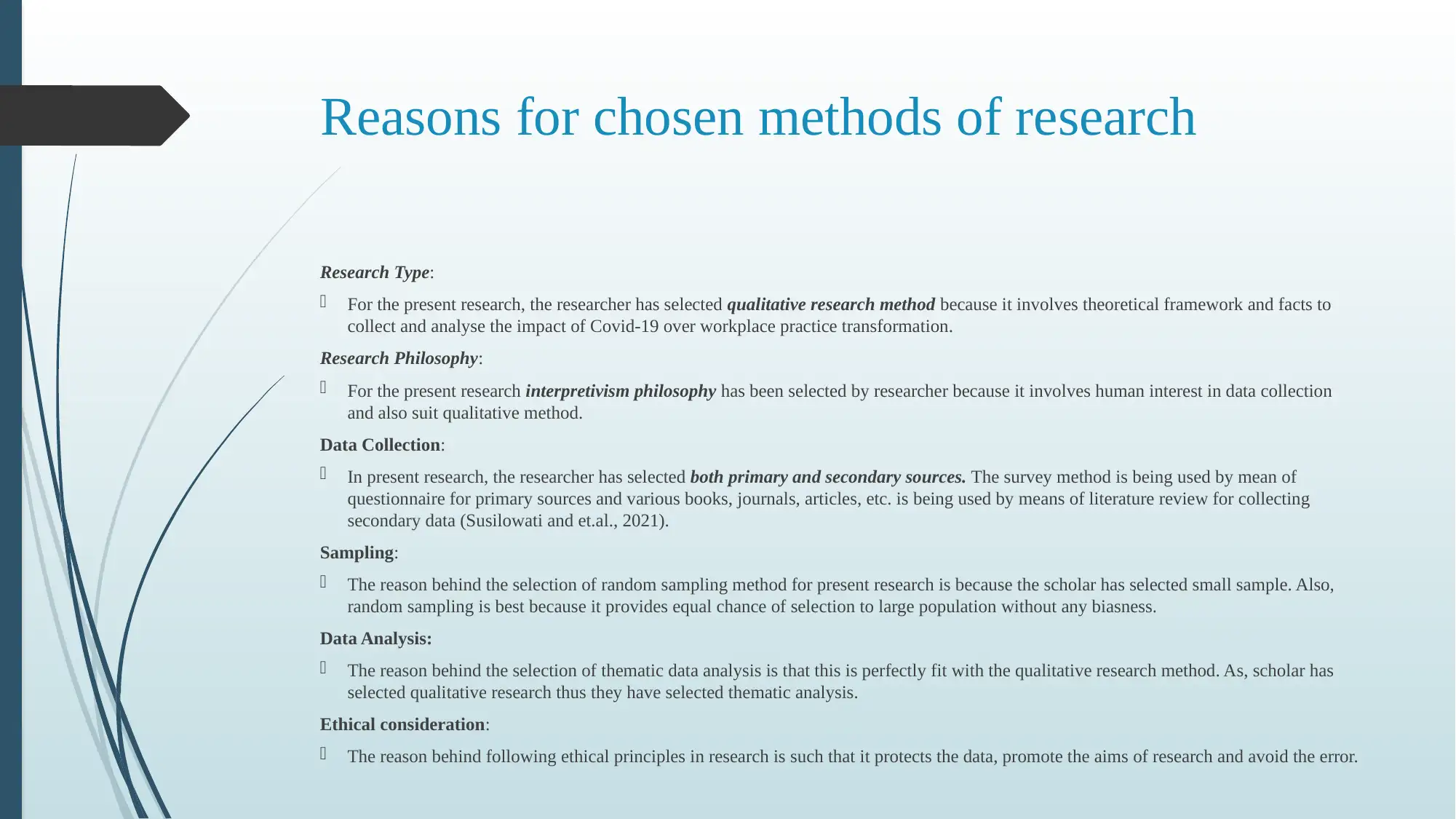
Reasons for chosen methods of research
Research Type:
For the present research, the researcher has selected qualitative research method because it involves theoretical framework and facts to
collect and analyse the impact of Covid-19 over workplace practice transformation.
Research Philosophy:
For the present research interpretivism philosophy has been selected by researcher because it involves human interest in data collection
and also suit qualitative method.
Data Collection:
In present research, the researcher has selected both primary and secondary sources. The survey method is being used by mean of
questionnaire for primary sources and various books, journals, articles, etc. is being used by means of literature review for collecting
secondary data (Susilowati and et.al., 2021).
Sampling:
The reason behind the selection of random sampling method for present research is because the scholar has selected small sample. Also,
random sampling is best because it provides equal chance of selection to large population without any biasness.
Data Analysis:
The reason behind the selection of thematic data analysis is that this is perfectly fit with the qualitative research method. As, scholar has
selected qualitative research thus they have selected thematic analysis.
Ethical consideration:
The reason behind following ethical principles in research is such that it protects the data, promote the aims of research and avoid the error.
Research Type:
For the present research, the researcher has selected qualitative research method because it involves theoretical framework and facts to
collect and analyse the impact of Covid-19 over workplace practice transformation.
Research Philosophy:
For the present research interpretivism philosophy has been selected by researcher because it involves human interest in data collection
and also suit qualitative method.
Data Collection:
In present research, the researcher has selected both primary and secondary sources. The survey method is being used by mean of
questionnaire for primary sources and various books, journals, articles, etc. is being used by means of literature review for collecting
secondary data (Susilowati and et.al., 2021).
Sampling:
The reason behind the selection of random sampling method for present research is because the scholar has selected small sample. Also,
random sampling is best because it provides equal chance of selection to large population without any biasness.
Data Analysis:
The reason behind the selection of thematic data analysis is that this is perfectly fit with the qualitative research method. As, scholar has
selected qualitative research thus they have selected thematic analysis.
Ethical consideration:
The reason behind following ethical principles in research is such that it protects the data, promote the aims of research and avoid the error.
⊘ This is a preview!⊘
Do you want full access?
Subscribe today to unlock all pages.

Trusted by 1+ million students worldwide
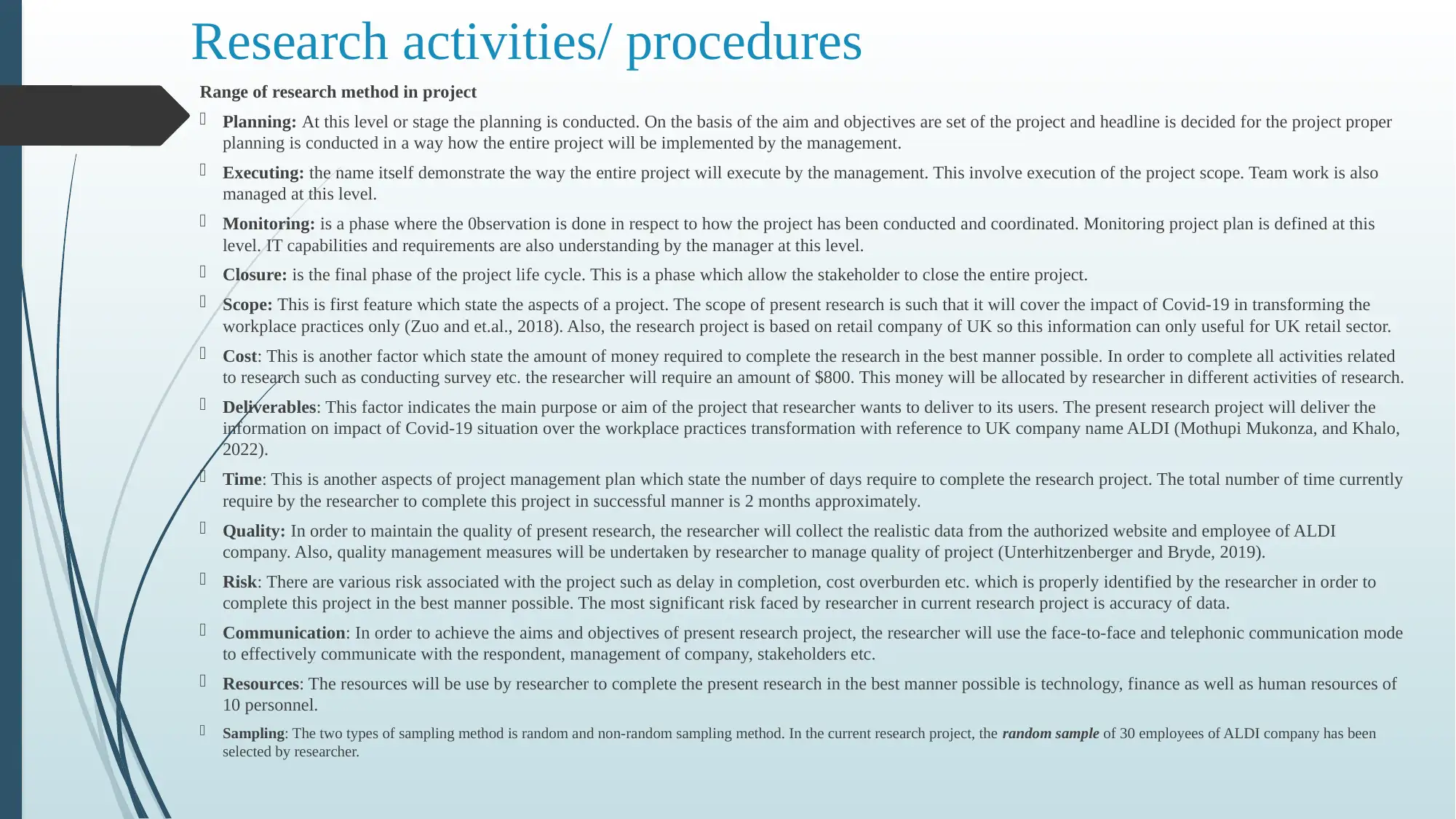
Research activities/ procedures
Range of research method in project
Planning: At this level or stage the planning is conducted. On the basis of the aim and objectives are set of the project and headline is decided for the project proper
planning is conducted in a way how the entire project will be implemented by the management.
Executing: the name itself demonstrate the way the entire project will execute by the management. This involve execution of the project scope. Team work is also
managed at this level.
Monitoring: is a phase where the 0bservation is done in respect to how the project has been conducted and coordinated. Monitoring project plan is defined at this
level. IT capabilities and requirements are also understanding by the manager at this level.
Closure: is the final phase of the project life cycle. This is a phase which allow the stakeholder to close the entire project.
Scope: This is first feature which state the aspects of a project. The scope of present research is such that it will cover the impact of Covid-19 in transforming the
workplace practices only (Zuo and et.al., 2018). Also, the research project is based on retail company of UK so this information can only useful for UK retail sector.
Cost: This is another factor which state the amount of money required to complete the research in the best manner possible. In order to complete all activities related
to research such as conducting survey etc. the researcher will require an amount of $800. This money will be allocated by researcher in different activities of research.
Deliverables: This factor indicates the main purpose or aim of the project that researcher wants to deliver to its users. The present research project will deliver the
information on impact of Covid-19 situation over the workplace practices transformation with reference to UK company name ALDI (Mothupi Mukonza, and Khalo,
2022).
Time: This is another aspects of project management plan which state the number of days require to complete the research project. The total number of time currently
require by the researcher to complete this project in successful manner is 2 months approximately.
Quality: In order to maintain the quality of present research, the researcher will collect the realistic data from the authorized website and employee of ALDI
company. Also, quality management measures will be undertaken by researcher to manage quality of project (Unterhitzenberger and Bryde, 2019).
Risk: There are various risk associated with the project such as delay in completion, cost overburden etc. which is properly identified by the researcher in order to
complete this project in the best manner possible. The most significant risk faced by researcher in current research project is accuracy of data.
Communication: In order to achieve the aims and objectives of present research project, the researcher will use the face-to-face and telephonic communication mode
to effectively communicate with the respondent, management of company, stakeholders etc.
Resources: The resources will be use by researcher to complete the present research in the best manner possible is technology, finance as well as human resources of
10 personnel.
Sampling: The two types of sampling method is random and non-random sampling method. In the current research project, the random sample of 30 employees of ALDI company has been
selected by researcher.
Range of research method in project
Planning: At this level or stage the planning is conducted. On the basis of the aim and objectives are set of the project and headline is decided for the project proper
planning is conducted in a way how the entire project will be implemented by the management.
Executing: the name itself demonstrate the way the entire project will execute by the management. This involve execution of the project scope. Team work is also
managed at this level.
Monitoring: is a phase where the 0bservation is done in respect to how the project has been conducted and coordinated. Monitoring project plan is defined at this
level. IT capabilities and requirements are also understanding by the manager at this level.
Closure: is the final phase of the project life cycle. This is a phase which allow the stakeholder to close the entire project.
Scope: This is first feature which state the aspects of a project. The scope of present research is such that it will cover the impact of Covid-19 in transforming the
workplace practices only (Zuo and et.al., 2018). Also, the research project is based on retail company of UK so this information can only useful for UK retail sector.
Cost: This is another factor which state the amount of money required to complete the research in the best manner possible. In order to complete all activities related
to research such as conducting survey etc. the researcher will require an amount of $800. This money will be allocated by researcher in different activities of research.
Deliverables: This factor indicates the main purpose or aim of the project that researcher wants to deliver to its users. The present research project will deliver the
information on impact of Covid-19 situation over the workplace practices transformation with reference to UK company name ALDI (Mothupi Mukonza, and Khalo,
2022).
Time: This is another aspects of project management plan which state the number of days require to complete the research project. The total number of time currently
require by the researcher to complete this project in successful manner is 2 months approximately.
Quality: In order to maintain the quality of present research, the researcher will collect the realistic data from the authorized website and employee of ALDI
company. Also, quality management measures will be undertaken by researcher to manage quality of project (Unterhitzenberger and Bryde, 2019).
Risk: There are various risk associated with the project such as delay in completion, cost overburden etc. which is properly identified by the researcher in order to
complete this project in the best manner possible. The most significant risk faced by researcher in current research project is accuracy of data.
Communication: In order to achieve the aims and objectives of present research project, the researcher will use the face-to-face and telephonic communication mode
to effectively communicate with the respondent, management of company, stakeholders etc.
Resources: The resources will be use by researcher to complete the present research in the best manner possible is technology, finance as well as human resources of
10 personnel.
Sampling: The two types of sampling method is random and non-random sampling method. In the current research project, the random sample of 30 employees of ALDI company has been
selected by researcher.
Paraphrase This Document
Need a fresh take? Get an instant paraphrase of this document with our AI Paraphraser
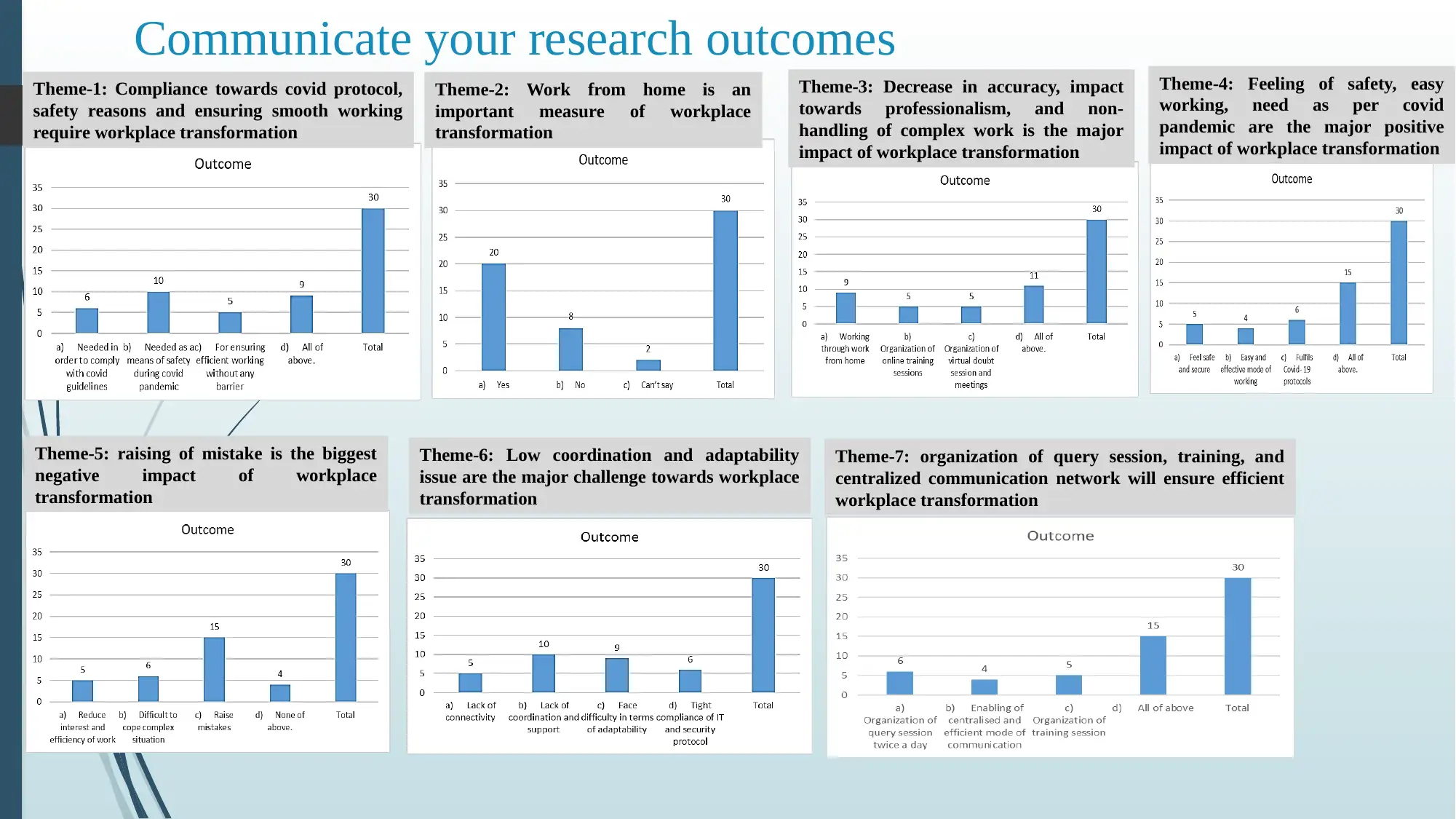
Communicate your research outcomes
Theme-1: Compliance towards covid protocol,
safety reasons and ensuring smooth working
require workplace transformation
Theme-2: Work from home is an
important measure of workplace
transformation
Theme-3: Decrease in accuracy, impact
towards professionalism, and non-
handling of complex work is the major
impact of workplace transformation
Theme-4: Feeling of safety, easy
working, need as per covid
pandemic are the major positive
impact of workplace transformation
Theme-5: raising of mistake is the biggest
negative impact of workplace
transformation
Theme-6: Low coordination and adaptability
issue are the major challenge towards workplace
transformation
Theme-7: organization of query session, training, and
centralized communication network will ensure efficient
workplace transformation
Theme-1: Compliance towards covid protocol,
safety reasons and ensuring smooth working
require workplace transformation
Theme-2: Work from home is an
important measure of workplace
transformation
Theme-3: Decrease in accuracy, impact
towards professionalism, and non-
handling of complex work is the major
impact of workplace transformation
Theme-4: Feeling of safety, easy
working, need as per covid
pandemic are the major positive
impact of workplace transformation
Theme-5: raising of mistake is the biggest
negative impact of workplace
transformation
Theme-6: Low coordination and adaptability
issue are the major challenge towards workplace
transformation
Theme-7: organization of query session, training, and
centralized communication network will ensure efficient
workplace transformation
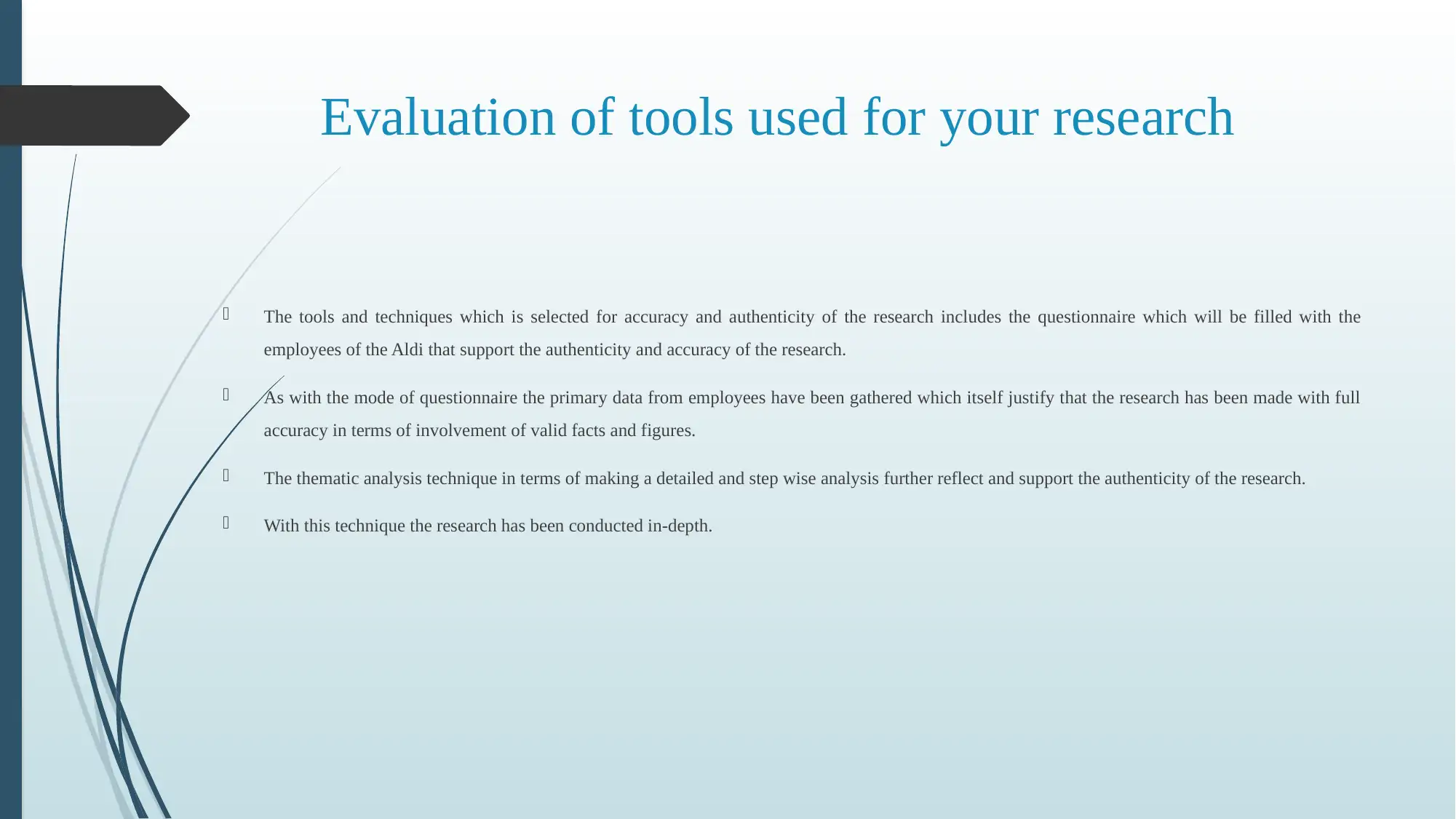
Evaluation of tools used for your research
The tools and techniques which is selected for accuracy and authenticity of the research includes the questionnaire which will be filled with the
employees of the Aldi that support the authenticity and accuracy of the research.
As with the mode of questionnaire the primary data from employees have been gathered which itself justify that the research has been made with full
accuracy in terms of involvement of valid facts and figures.
The thematic analysis technique in terms of making a detailed and step wise analysis further reflect and support the authenticity of the research.
With this technique the research has been conducted in-depth.
The tools and techniques which is selected for accuracy and authenticity of the research includes the questionnaire which will be filled with the
employees of the Aldi that support the authenticity and accuracy of the research.
As with the mode of questionnaire the primary data from employees have been gathered which itself justify that the research has been made with full
accuracy in terms of involvement of valid facts and figures.
The thematic analysis technique in terms of making a detailed and step wise analysis further reflect and support the authenticity of the research.
With this technique the research has been conducted in-depth.
⊘ This is a preview!⊘
Do you want full access?
Subscribe today to unlock all pages.

Trusted by 1+ million students worldwide
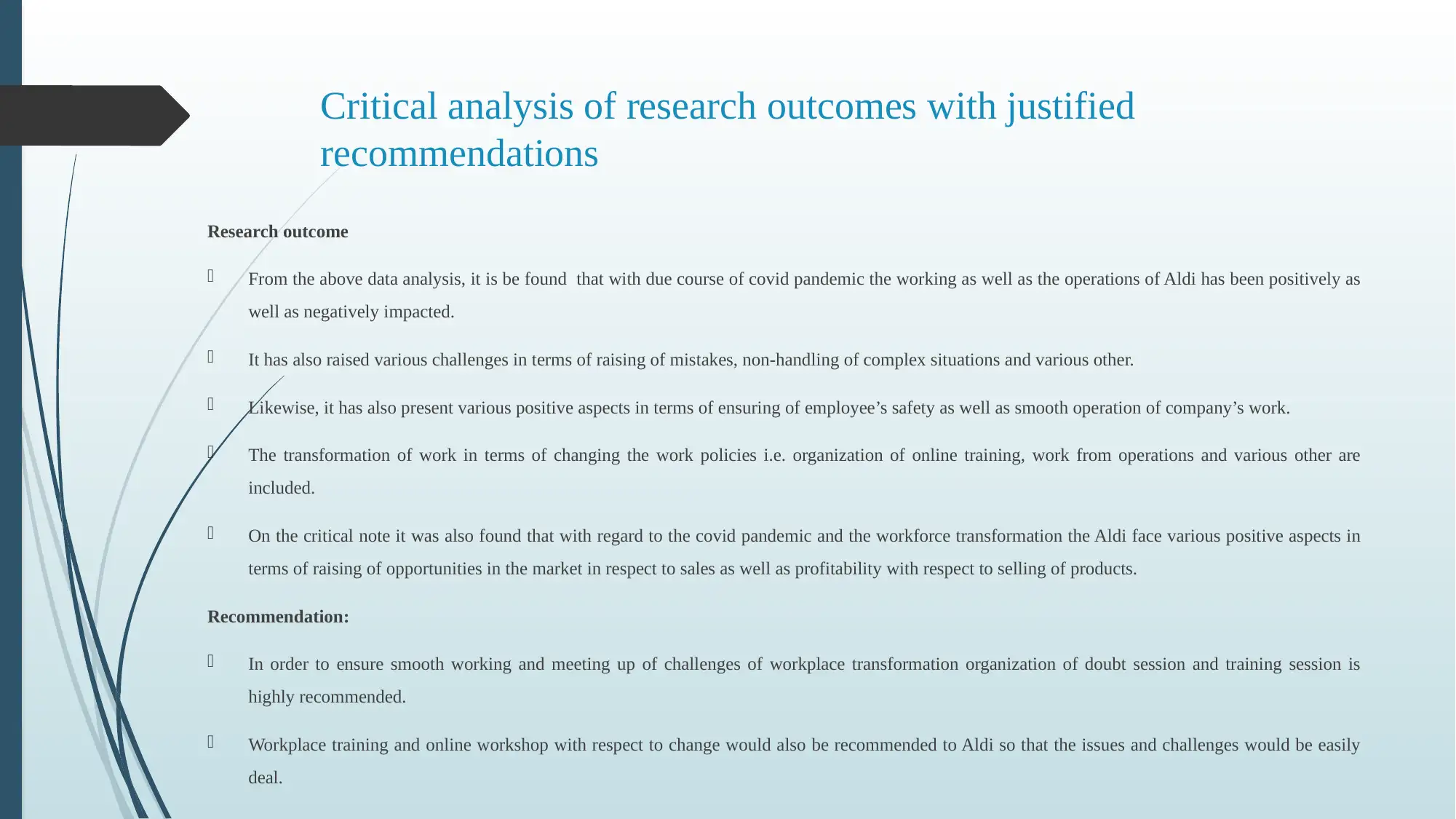
Critical analysis of research outcomes with justified
recommendations
Research outcome
From the above data analysis, it is be found that with due course of covid pandemic the working as well as the operations of Aldi has been positively as
well as negatively impacted.
It has also raised various challenges in terms of raising of mistakes, non-handling of complex situations and various other.
Likewise, it has also present various positive aspects in terms of ensuring of employee’s safety as well as smooth operation of company’s work.
The transformation of work in terms of changing the work policies i.e. organization of online training, work from operations and various other are
included.
On the critical note it was also found that with regard to the covid pandemic and the workforce transformation the Aldi face various positive aspects in
terms of raising of opportunities in the market in respect to sales as well as profitability with respect to selling of products.
Recommendation:
In order to ensure smooth working and meeting up of challenges of workplace transformation organization of doubt session and training session is
highly recommended.
Workplace training and online workshop with respect to change would also be recommended to Aldi so that the issues and challenges would be easily
deal.
recommendations
Research outcome
From the above data analysis, it is be found that with due course of covid pandemic the working as well as the operations of Aldi has been positively as
well as negatively impacted.
It has also raised various challenges in terms of raising of mistakes, non-handling of complex situations and various other.
Likewise, it has also present various positive aspects in terms of ensuring of employee’s safety as well as smooth operation of company’s work.
The transformation of work in terms of changing the work policies i.e. organization of online training, work from operations and various other are
included.
On the critical note it was also found that with regard to the covid pandemic and the workforce transformation the Aldi face various positive aspects in
terms of raising of opportunities in the market in respect to sales as well as profitability with respect to selling of products.
Recommendation:
In order to ensure smooth working and meeting up of challenges of workplace transformation organization of doubt session and training session is
highly recommended.
Workplace training and online workshop with respect to change would also be recommended to Aldi so that the issues and challenges would be easily
deal.
Paraphrase This Document
Need a fresh take? Get an instant paraphrase of this document with our AI Paraphraser
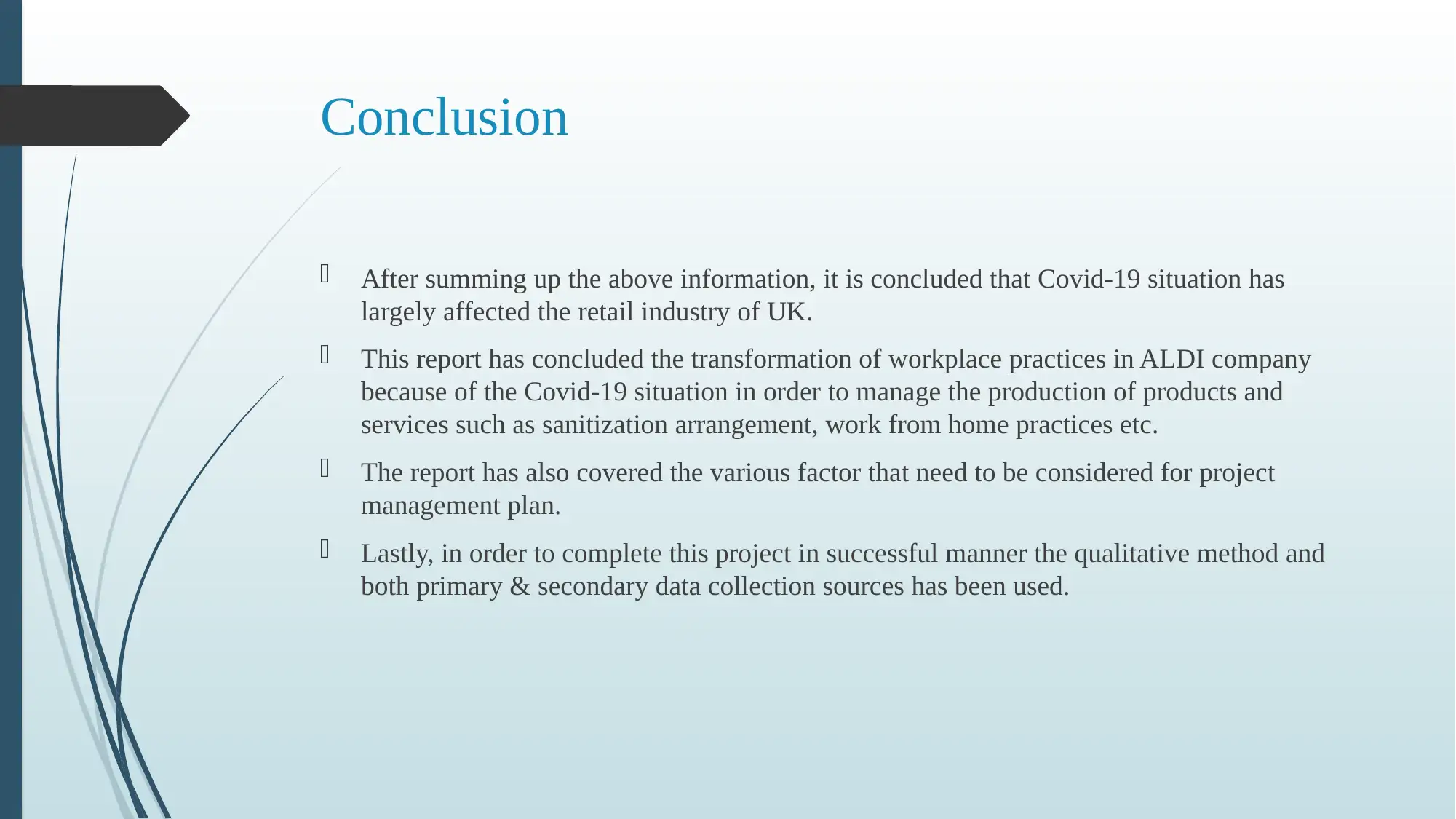
Conclusion
After summing up the above information, it is concluded that Covid-19 situation has
largely affected the retail industry of UK.
This report has concluded the transformation of workplace practices in ALDI company
because of the Covid-19 situation in order to manage the production of products and
services such as sanitization arrangement, work from home practices etc.
The report has also covered the various factor that need to be considered for project
management plan.
Lastly, in order to complete this project in successful manner the qualitative method and
both primary & secondary data collection sources has been used.
After summing up the above information, it is concluded that Covid-19 situation has
largely affected the retail industry of UK.
This report has concluded the transformation of workplace practices in ALDI company
because of the Covid-19 situation in order to manage the production of products and
services such as sanitization arrangement, work from home practices etc.
The report has also covered the various factor that need to be considered for project
management plan.
Lastly, in order to complete this project in successful manner the qualitative method and
both primary & secondary data collection sources has been used.
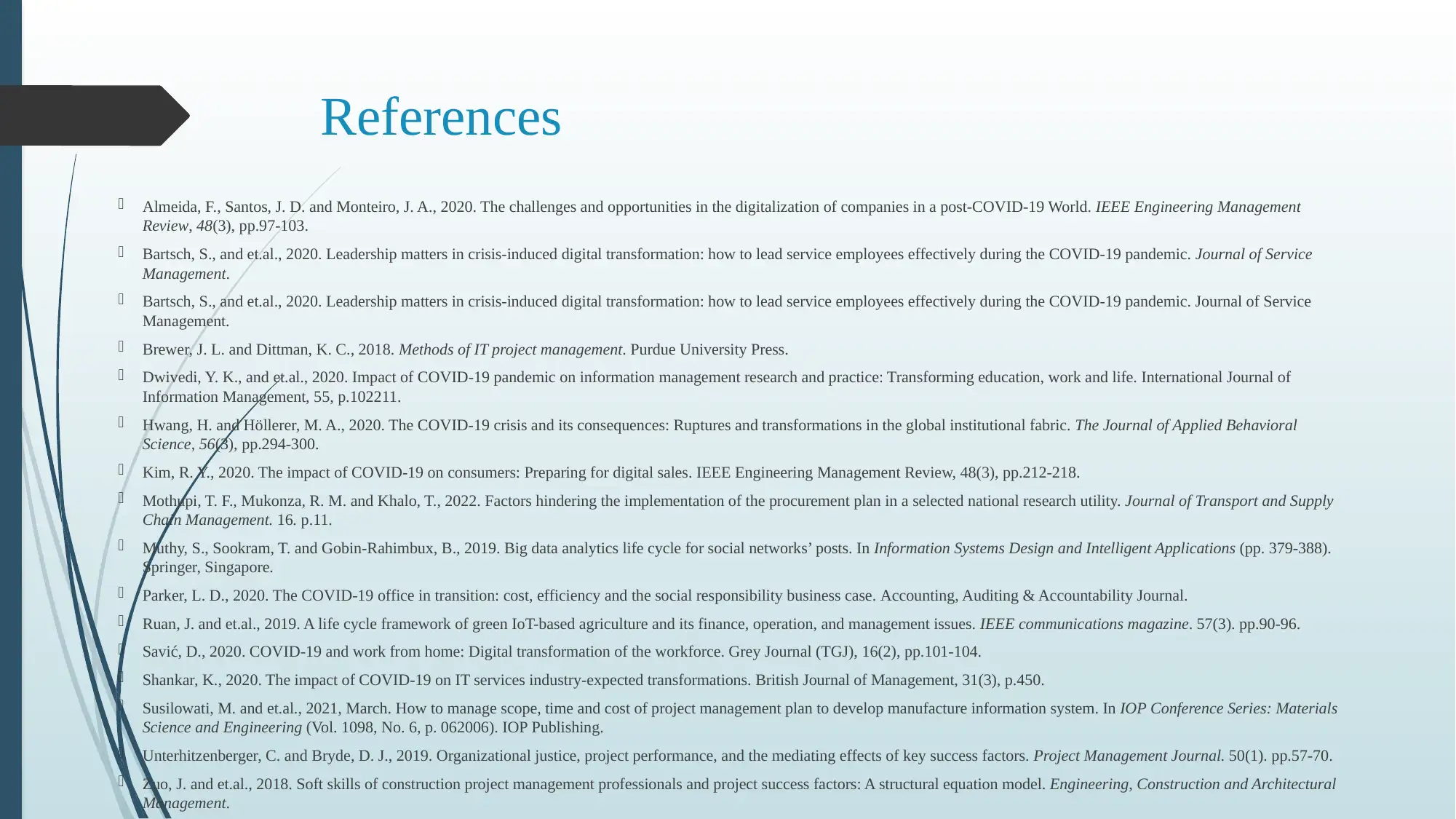
References
Almeida, F., Santos, J. D. and Monteiro, J. A., 2020. The challenges and opportunities in the digitalization of companies in a post-COVID-19 World. IEEE Engineering Management
Review, 48(3), pp.97-103.
Bartsch, S., and et.al., 2020. Leadership matters in crisis-induced digital transformation: how to lead service employees effectively during the COVID-19 pandemic. Journal of Service
Management.
Bartsch, S., and et.al., 2020. Leadership matters in crisis-induced digital transformation: how to lead service employees effectively during the COVID-19 pandemic. Journal of Service
Management.
Brewer, J. L. and Dittman, K. C., 2018. Methods of IT project management. Purdue University Press.
Dwivedi, Y. K., and et.al., 2020. Impact of COVID-19 pandemic on information management research and practice: Transforming education, work and life. International Journal of
Information Management, 55, p.102211.
Hwang, H. and Höllerer, M. A., 2020. The COVID-19 crisis and its consequences: Ruptures and transformations in the global institutional fabric. The Journal of Applied Behavioral
Science, 56(3), pp.294-300.
Kim, R. Y., 2020. The impact of COVID-19 on consumers: Preparing for digital sales. IEEE Engineering Management Review, 48(3), pp.212-218.
Mothupi, T. F., Mukonza, R. M. and Khalo, T., 2022. Factors hindering the implementation of the procurement plan in a selected national research utility. Journal of Transport and Supply
Chain Management. 16. p.11.
Muthy, S., Sookram, T. and Gobin-Rahimbux, B., 2019. Big data analytics life cycle for social networks’ posts. In Information Systems Design and Intelligent Applications (pp. 379-388).
Springer, Singapore.
Parker, L. D., 2020. The COVID-19 office in transition: cost, efficiency and the social responsibility business case. Accounting, Auditing & Accountability Journal.
Ruan, J. and et.al., 2019. A life cycle framework of green IoT-based agriculture and its finance, operation, and management issues. IEEE communications magazine. 57(3). pp.90-96.
Savić, D., 2020. COVID-19 and work from home: Digital transformation of the workforce. Grey Journal (TGJ), 16(2), pp.101-104.
Shankar, K., 2020. The impact of COVID‐19 on IT services industry‐expected transformations. British Journal of Management, 31(3), p.450.
Susilowati, M. and et.al., 2021, March. How to manage scope, time and cost of project management plan to develop manufacture information system. In IOP Conference Series: Materials
Science and Engineering (Vol. 1098, No. 6, p. 062006). IOP Publishing.
Unterhitzenberger, C. and Bryde, D. J., 2019. Organizational justice, project performance, and the mediating effects of key success factors. Project Management Journal. 50(1). pp.57-70.
Zuo, J. and et.al., 2018. Soft skills of construction project management professionals and project success factors: A structural equation model. Engineering, Construction and Architectural
Management.
Almeida, F., Santos, J. D. and Monteiro, J. A., 2020. The challenges and opportunities in the digitalization of companies in a post-COVID-19 World. IEEE Engineering Management
Review, 48(3), pp.97-103.
Bartsch, S., and et.al., 2020. Leadership matters in crisis-induced digital transformation: how to lead service employees effectively during the COVID-19 pandemic. Journal of Service
Management.
Bartsch, S., and et.al., 2020. Leadership matters in crisis-induced digital transformation: how to lead service employees effectively during the COVID-19 pandemic. Journal of Service
Management.
Brewer, J. L. and Dittman, K. C., 2018. Methods of IT project management. Purdue University Press.
Dwivedi, Y. K., and et.al., 2020. Impact of COVID-19 pandemic on information management research and practice: Transforming education, work and life. International Journal of
Information Management, 55, p.102211.
Hwang, H. and Höllerer, M. A., 2020. The COVID-19 crisis and its consequences: Ruptures and transformations in the global institutional fabric. The Journal of Applied Behavioral
Science, 56(3), pp.294-300.
Kim, R. Y., 2020. The impact of COVID-19 on consumers: Preparing for digital sales. IEEE Engineering Management Review, 48(3), pp.212-218.
Mothupi, T. F., Mukonza, R. M. and Khalo, T., 2022. Factors hindering the implementation of the procurement plan in a selected national research utility. Journal of Transport and Supply
Chain Management. 16. p.11.
Muthy, S., Sookram, T. and Gobin-Rahimbux, B., 2019. Big data analytics life cycle for social networks’ posts. In Information Systems Design and Intelligent Applications (pp. 379-388).
Springer, Singapore.
Parker, L. D., 2020. The COVID-19 office in transition: cost, efficiency and the social responsibility business case. Accounting, Auditing & Accountability Journal.
Ruan, J. and et.al., 2019. A life cycle framework of green IoT-based agriculture and its finance, operation, and management issues. IEEE communications magazine. 57(3). pp.90-96.
Savić, D., 2020. COVID-19 and work from home: Digital transformation of the workforce. Grey Journal (TGJ), 16(2), pp.101-104.
Shankar, K., 2020. The impact of COVID‐19 on IT services industry‐expected transformations. British Journal of Management, 31(3), p.450.
Susilowati, M. and et.al., 2021, March. How to manage scope, time and cost of project management plan to develop manufacture information system. In IOP Conference Series: Materials
Science and Engineering (Vol. 1098, No. 6, p. 062006). IOP Publishing.
Unterhitzenberger, C. and Bryde, D. J., 2019. Organizational justice, project performance, and the mediating effects of key success factors. Project Management Journal. 50(1). pp.57-70.
Zuo, J. and et.al., 2018. Soft skills of construction project management professionals and project success factors: A structural equation model. Engineering, Construction and Architectural
Management.
⊘ This is a preview!⊘
Do you want full access?
Subscribe today to unlock all pages.

Trusted by 1+ million students worldwide
1 out of 12
Related Documents
Your All-in-One AI-Powered Toolkit for Academic Success.
+13062052269
info@desklib.com
Available 24*7 on WhatsApp / Email
![[object Object]](/_next/static/media/star-bottom.7253800d.svg)
Unlock your academic potential
Copyright © 2020–2025 A2Z Services. All Rights Reserved. Developed and managed by ZUCOL.




